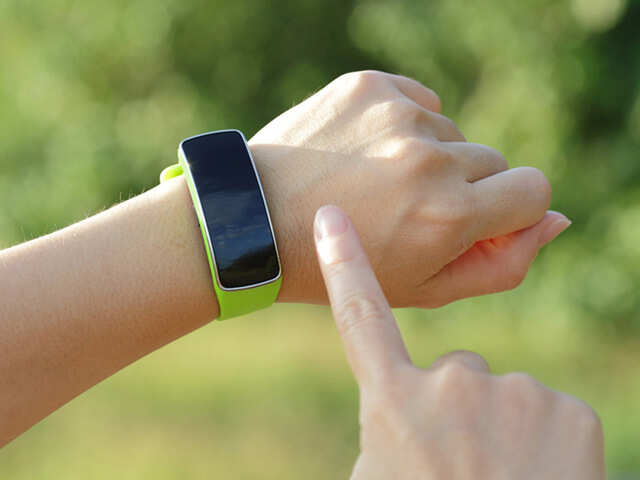16 sensors that are present inside fitness bands and smartwatches that you need to know

Fitness trackers and smartwatches are slowly becoming essential lifestyle devices that helps track how active you are along with basic health parameters. But in order to help you measure activity levels and heart health, there’s a lot of tech inside those tiny devices that you wear on your wrist. Any typical fitness band or smartwatch comes with around 16 sensors inside. Some may have more and some less depending on the price. These sensors along with other hardware components like battery, mic, display, speakers, etc and capable high-end software makes a fitness tracker or smartwatch. Here are all sensors inside a wearable that you should know.
Ambient light sensor to tweak display brightness
Most fitness trackers and smartwatches come with an ambient light sensor. It’s primary job is to tweak the brightness of the display as per surrounding light. This also helps in saving battery life.
3 axis accelerometer detects movement and tracks direction
3 axis accelerometer is the most common sensor that you will find inside a wearable. This sensor can track forward and backward movements, sense gravity and determine body’s orientation, position and also rate of speed change.
Altimeter detects how much you are climbing
Altimeter simply detects changes in height. It helps detect whether you are climbing stairs or going down a slope and accordingly helps in measuring calorie count.
Optical heart rate sensor detects heart beats per minute
Almost every fitness tracker comes with an optical heart rate sensor. It’s job is to calculate your heart beats per minute. The sensor uses light to check the speed of blood flow on the wrist. When the heart beats, blood moves quickly inside the artery thus less light is reflected back to the sensor and is detected as a heart beat.
SpO2 monitor to measure blood oxygen levels
The colour of blood is examined by the sensor to understand the oxygen levels present in it. As Fitbit explains, “Deoxygenated blood, which is returned to your lungs via your veins, is a slightly darker red color than the fully oxygenated blood in your arteries. The sensors measure the relative reflection of red and infrared light from your blood via your wrist, and seeing how it varies as your heart beats, the device estimates your SpO2 value.”
Bioimpedance sensor to measure respiratory rate, sleep, etc
A bioimpedance sensor measures the resistance that your skin is offering to a small amount of electricity. The battery charger electrodes in the fitness tracker deliver a very small amount of current to measure sleep, heart rate, respiration rate, water level and more.
Proximity sensor saves battery and wakes the display when needed
Proximity sensor simply lets the device know that you are near the device and wants to use it. If you are not wearing the fitness tracker, this sensor enables the device to sleep and save battery when not in use. It is mostly used to turn on or off the display screen.
Compass helps is direction and Maps
A compass helps Map applications to run on a smartwatch and also gives the device a sense of direction.
ECG sensor
ECG sensor is a new addition to wearables. Now, the job of this sensor is to detect the minute electrical impulse that your heart sends out with every heartbeat. This sensor detects this minute heart signal through the electrodes on the wearable.
GPS
GPS simply helps in detecting how much you are running, the location of the wearable and track your activity. It also helps in guiding Map applications.
Gyroscope
Technically gyroscopes measure angular velocity which is used to detect motion, track them accurately when you are on the go. For example, data from gyroscopes along with other sensors can determine whether you are actually running or simply jogging at one place. Also, it helps eliminate motion from violent shake of the wrist and mistake it for an intense running session.
Gesture sensors detect wrist motion
Gesture sensors can instruct the smartwatch to do certain activity when the hand is moved in a certain way. For example, if a wrist is flicked twice, the call will be disconnected or when the hand is moved in circles the stopwatch will start. Detecting these pre-fed motion is the job of gesture sensors.
UV sensor measure exposure to harmful sunlight
Some smartwatches also offer whether the sunlight outdoors is harmful or not. This is detected by the UV sensor which detects the UV radiation when you step outside.
Magnetometer
A magnetometer works along with the GPS and compass to determine the exact coordinates of your location.
Electrodermal activity sensor
Electrodermal activity or EDA sensor is a new addition to wearables. It measure stress along with a heart rate tracker, ECG and skin temperature sensor. It detects small electrical changes in the sweat level of your skin and helps you manage your stress.
Skin temperature sensor
Skin temperature sensor detects slight changes in temperature to understand whether you are going to fall sick like fever or detect a start of menstrual phase.
Ambient light sensor to tweak display brightness
Most fitness trackers and smartwatches come with an ambient light sensor. It’s primary job is to tweak the brightness of the display as per surrounding light. This also helps in saving battery life.
3 axis accelerometer detects movement and tracks direction
3 axis accelerometer is the most common sensor that you will find inside a wearable. This sensor can track forward and backward movements, sense gravity and determine body’s orientation, position and also rate of speed change.
Altimeter detects how much you are climbing
Altimeter simply detects changes in height. It helps detect whether you are climbing stairs or going down a slope and accordingly helps in measuring calorie count.
Optical heart rate sensor detects heart beats per minute
Almost every fitness tracker comes with an optical heart rate sensor. It’s job is to calculate your heart beats per minute. The sensor uses light to check the speed of blood flow on the wrist. When the heart beats, blood moves quickly inside the artery thus less light is reflected back to the sensor and is detected as a heart beat.
SpO2 monitor to measure blood oxygen levels
The colour of blood is examined by the sensor to understand the oxygen levels present in it. As Fitbit explains, “Deoxygenated blood, which is returned to your lungs via your veins, is a slightly darker red color than the fully oxygenated blood in your arteries. The sensors measure the relative reflection of red and infrared light from your blood via your wrist, and seeing how it varies as your heart beats, the device estimates your SpO2 value.”
Bioimpedance sensor to measure respiratory rate, sleep, etc
A bioimpedance sensor measures the resistance that your skin is offering to a small amount of electricity. The battery charger electrodes in the fitness tracker deliver a very small amount of current to measure sleep, heart rate, respiration rate, water level and more.
Proximity sensor saves battery and wakes the display when needed
Proximity sensor simply lets the device know that you are near the device and wants to use it. If you are not wearing the fitness tracker, this sensor enables the device to sleep and save battery when not in use. It is mostly used to turn on or off the display screen.
Compass helps is direction and Maps
A compass helps Map applications to run on a smartwatch and also gives the device a sense of direction.
ECG sensor
ECG sensor is a new addition to wearables. Now, the job of this sensor is to detect the minute electrical impulse that your heart sends out with every heartbeat. This sensor detects this minute heart signal through the electrodes on the wearable.
GPS
GPS simply helps in detecting how much you are running, the location of the wearable and track your activity. It also helps in guiding Map applications.
Gyroscope
Technically gyroscopes measure angular velocity which is used to detect motion, track them accurately when you are on the go. For example, data from gyroscopes along with other sensors can determine whether you are actually running or simply jogging at one place. Also, it helps eliminate motion from violent shake of the wrist and mistake it for an intense running session.
Gesture sensors detect wrist motion
Gesture sensors can instruct the smartwatch to do certain activity when the hand is moved in a certain way. For example, if a wrist is flicked twice, the call will be disconnected or when the hand is moved in circles the stopwatch will start. Detecting these pre-fed motion is the job of gesture sensors.
UV sensor measure exposure to harmful sunlight
Some smartwatches also offer whether the sunlight outdoors is harmful or not. This is detected by the UV sensor which detects the UV radiation when you step outside.
Magnetometer
A magnetometer works along with the GPS and compass to determine the exact coordinates of your location.
Electrodermal activity sensor
Electrodermal activity or EDA sensor is a new addition to wearables. It measure stress along with a heart rate tracker, ECG and skin temperature sensor. It detects small electrical changes in the sweat level of your skin and helps you manage your stress.
Skin temperature sensor
Skin temperature sensor detects slight changes in temperature to understand whether you are going to fall sick like fever or detect a start of menstrual phase.



























All Comments (0)+^ Back to Top
Refrain from posting comments that are obscene, defamatory or inflammatory, and do not indulge in personal attacks, name calling or inciting hatred against any community. Help us delete comments that do not follow these guidelines by marking them offensive. Let's work together to keep the conversation civil.
HIDE